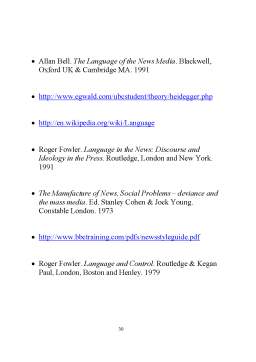Cuprins
- Introduction . 2
- The Role of Media . 3
- News as Stories .7
- Styling the News . 9
- Headlines . 13
- Stereotypes in the News . 18
- David Ennals and Powerless Patientes: Language in the Sunday Times . 25
- Conclusion . 29
- References . 30
Extras din proiect
“People in Western countries
probably hear more language from media than
they do directly from the lips of their
fellow humans in conversation. Society is
pervaded by media language.”
Picture yourself in a world in which the individual would dispose if no means of communication whatever, in which language has lost its roles as mediator between thought and reality, in which Man would have to strain himself tremendously in order to give vent to his feelings and ideas and, moreover, to share his emotions and beliefs with his fellows. The existence of such a world remote from media and, most importantly, from language as “a set of characters, conventions, and rules used to convey ideas and information” is unconceivable. According to Ferdinand de Saussure, “language is form, a system of sound images linked to ideas.” A definition of language we have found on the wikipedia: “Language is a system of finite arbitrary symbols combined according to rules of grammar for the purpose of communication. Individual languages use sounds, gestures and other symbols to represent objects, concepts, emotions, ideas, and thoughts.”
Within this brief introduction we will try to respond to the following questions:
1. What is the function of media and implicitly, of media language?
2. Why has it gained so much power and has become so influential?
3. What are the advantages of media language?
4. How does it convey reality?
5. What are its effects upon the reading population?
According to both Roger Fowler, as well as Allan Bell, the role of media is crucial, since it is through it that reality unfolds itself. In time it has gained an overwhelming amount of importance and influence; in fact, nowadays, one can freely state that it has become indispensable, since it is news which carry “the stories and images of our day.” And, since it is language in the news that we are particularly interested in, we can ask ourselves: what is the fundamental role of media language? It is Roger Fowler who briefly and precisely points out the function of language: it is used to “form ideas and beliefs.” Furthermore, Fowler continues by stating that “the journalist collects facts, reports them objectively and the newspaper presents them fairly and without bias, in language whish is designed to be unambiguous, undistorting and agreeable to readers.” Therefore, the readers are provided with a clear, unembroidered image of the society they live in, they are permanently in touch with the state of the world, of the political, economical, cultural, religious developments occurring at one particular moment in time. Moreover, “language is an essential part of the content of what media purvey to us. That is, language is a tool and expression of media messages.” Thus, language is the essential means or tool of revealing reality. Fair or cruel, cheerful or gloomy comic or tragic, huge or tiny, dazzling or pedestrian the world, the society shared by us, the individuals, unfolds itself in the white and black, freshly printed columns of a newspaper.
Repeatedly throughout the study books, we chosen for this topic, referenced are made to the “way in which language is carries” the content of the messages transmitted to the readers, to the fact that media creates an image of the world which may not be as neutral as it seems. Taking into consideration the fact that “the production of media language is huge” and that “media language is heard not just by one or two people but by mass audiences” , one can put oneself the following question: is media language really neutral and 100% objective or does media take advantage of its inexhaustible resource namely language and uses it in order to imperceptibly exercise control on the mass audience?
In the introduction to “The Manufacture of News” social problems, deviance and the mass media “two pets of slogans: one found on the walls of Paris in May 1968, the other in the headlines and advertisements carried in our national newspapers every day” are presented:
UNDER THE PAVING STONES ANRGY BRIGADE: SEX
THE BEACH ORGIES AT THE COTTAGE
OF BLOOD
CONSUME MORE? THEN YOU A DREAM CAR FOR YOU!
LIVE LESS
THERE’S NOTHING THEY WON’T HAPPINESS IS $ SHAPED
DO TO RAISE THE STANDARD OF
BOREDOM
PLAY WITHOUT RESTRAINTS AND NEW ‘GET TOUGH’
LIVE WITHOUT DEAD TIME MEASURES ON DRUG
PROBLEM
ALL POWER TO THE IMAGINATION WHO ARE BRITAIN’S
SMUT PEDLARS?
BE REALISTIC, DEMAND THE ‘MILITANT TEACHERS
IMPOSSIBLE INFILTRATING SCHOOLS’
CLAIMS HEADMASTER
Preview document
Conținut arhivă zip
- Language in the News.doc













































